John Hurrell – 21 January, 2025
Moving light, shadow, line, projected colour and after-images (and sometimes sound or even smell) are the ingredients he usually exploits in the gallery space to grab your immediate attention. Here in Auckland we have an excellent indoor gallery show, but Eliasson's most famous works are often his sensational outdoor public sculptures that are highly elemental, very physical, surprisingly simple in idea or form, and deliciously spectacular. Insanely so!
Auckland
Olafur Eliasson
Your curious journey
7 December 2024 - 23 March 2025
Helping them analyse the bodily, as well as the processes of evaluation, this exceptionally ambitious and technologically ununusual Olafur Eliasson sampler takes the perambulating gallery visitor—through encountering novel modifications of given local architecture—to spatial and tactile realms normally hitherto unexplored, testing their powers of observation and analysis while letting them have fun doing so.
In this brilliant exhibition, a wide range of chromatic, graphic, spatial, moisture and light-based encounters are presented within the limitations of a conventional painting-oriented gallery building—each experience (as an artwork) usually linked in some way to the alarming symptoms of climate change, and focussing in some way of the viewer’s perceptual processes. Plus this Icelandic-Danish artist loves the phenomenon of dance (especially break-dance) and this interest in physicality impacts bodily on the nature of the exhibits, especially those incorporating the moving human form. It is also overtly political in its oblique references to the safety of our planet and its inhabitants.
Eliasson’s work is a wonderful synthesis of scientific research (in terms of theory and complex technology) not usually encountered in art galleries, complicated sculpture made from highly finished industrial materials or more organic natural ones (such as those using steam or fog). Of New Zealand artists, the closest in sensibility (particularly in relation to the study of light) would be the more intimate Bill Culbert.
The eighteen projects in this extraordinary Auckland survey tend to explore perception via multiple forms of bodily and spatial awareness, kickstarted through meticulously planned installations that often incorporate intricate underpinning processual patterns from engineering, maths and science. A wide range of disciplines is embraced through the work of the various research teams of experts he organises to implement each project, collectively of about 100 strong (of for example architects, designers, craftspersons, researchers, and technicians); the results being highly spectacular, huge in scale, and usually aimed at inner-city communities. They can be didactic, but only in an oblique fashion: they are rarely in-your-face tub thumping. First the body responds, then the mind—when analytical language kicks in.
Moving light, shadow, line, projected colour and after-images (and sometimes sound or even smell) are the ingredients he usually exploits in the gallery space to grab your immediate attention. Here in Auckland we have an excellent indoor gallery show, but Eliasson’s most famous works are often his sensational outdoor public sculptures that are highly elemental, very physical, surprisingly simple in idea or form, and deliciously spectacular. Insanely so.
Works such as the extraordinary Waterfall (2016), Reverse Waterfall (1998), The Weather the Weather (2016), or Double Sunset (1999) are wildly heart-stopping. (The thick yellow Phaidon publication on his career is endlessly fascinating, for Michelle Kuo’s in depth essay is a great read. This book is available in the city library and so you can take it home, as I did.)
This is an exhilarating show that thrills children as well as adults, who gasp immediately that the gallery can be a source of play. The rooms juxtapose opposites so that some projects are physically, ideationally and spatially (but not perceptually) very simple, and others mechanically very complicated, with lots of interconnected parts and layerings.
The included works can be divided into several categories. Though smaller than his very famous overseas outdoor sculptures, they are nevertheless completely captivating (gaining in intimacy what they might comparatively lose in vicarious thrills)—through their intimacy, sensuality, love of geometry and shadows, interest in sequencing, unravelling of logic, and mesmerising detail:
Firstly there is a wall of photographic documentation focussing on physical changes in the environment over recent time (eg. the melting of glaciers through thirty pairs of comparable images). In The Glacial Melt Series, 1999/2019, we compare icy forms, small lakes and scoured rockforms separated by a period of twenty years. The alarming dramatic differences make us pause for thought.
Then physical changes over time are also examined more directly, without photography, such as those detectable in a large wall of reindeer moss, as it dries, shrinks and fades, giving off a faint scent. (Moss Wall, 1994) This work is related also to another of three large blocks of ice (made with water from the Waikato River) melting and tinkling into a large steel tray that collects the water so it can be later refrozen again. (Still River, 2010). The beauty of the big transparent dissolving cubes takes you by surprise, as does the delicate sound of the dripping water.
In another project, we find seven painted, pock-marked and waxed bronze sculptures representing hunks of ice presented in a diminishing sequence of melting forms, juxtaposed with seven clear glass balls growing in size as the amount of lost water increases. (The Last Seven Days of Glacial Ice, 2024.) Another work is where two concentric circles of two differently-sized glass spheres are coloured in a spectral range, each ball split into black or clear so black is on the wall side, allowing their rainbow colours to change according to the precise position of the viewer in the room and its relationship to the circles. (Endlessly Happy Invisible Endings, 2023)
One further item projects light through a series of suspended light-house lenses (Circumstellar Resonator, 2018) or through the shells of complex, internally contained spheres made of steel rods holding glass triangles (Firefly Biosphere (Falling Magma Star), 2023), in order to scatter dramatic fragmented images around the walls of the containing room.
Now and then cunningly positioned coloured lights are used to cast overlapping coloured silhouettes of gallery visitors moving on large translucent screens (Multiple Shadow House, 2010), or make linear shadows from suspended geometric forms (Life is Lived Along Lines, 2009). Or the ceilings, walls and floor of a long corridor are covered in bright yellow (through the extensive use of yellow bulbs) to generate pale blue and purple after-images in the exhausted retinas of slightly dazed perambulating visitors. (Yellow Corridor, 1997)
One sculpture (Adrift Compass, 2019) specifically references orientation and aligned direction: a suspended, weathered, tide-washed, desicated tree trunk made into a functioning compass by being painted with a ‘rose’ of diverging arrows at one end and bolted to a large magnet.
The largest work in the exhibition is Under the Weather, 2022, a whopper, patterned elliptical screen of textiles with radiating light, suspended from the ceiling, that seems to change its shape and optical configurations as the viewer moves around the room below it. Its complexity makes it appear to be a living entity in itself.
Two sculptures (my personal favourites) reveal light projected on to vertical jets of water. Beauty, 1993, involves a curtain of thin mist falling from the ceiling, where the light coating it reveals the spectral hues of a rainbow. In Object Defined by Activity (Then), 2009, a single jet is lit up by the staccato illumination of a single strobe so that that the descending drooping jet is caught in sudden bursts. These freeze its splayed droplets in mid-air so it looks solid, as if it were a multi-legged spider cast in silver.
These—and three suites of ‘sensitive’ drawings made by inkcoated ballbearings moved on circular paper sheets by the movement of transporting trucks, the sun and wind—are particularly extraordinary!
This show is a real treat: it is consistently enthralling and has wide appeal, being diverse, relevant, and full of optical surprises. It has an admission charge, but if you take your time and look at what is presented carefully, the visit is well worth it.
John Hurrell
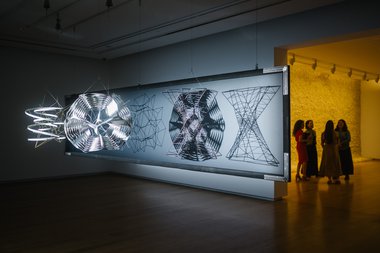
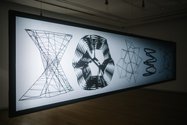
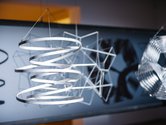


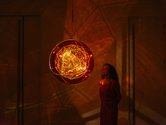
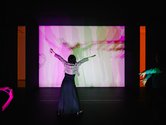
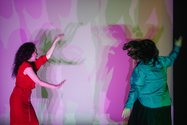
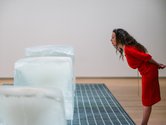

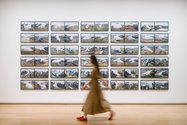
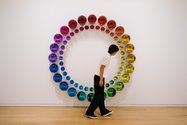
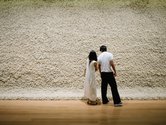
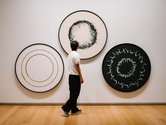
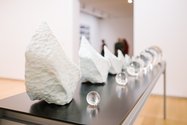

 Two Rooms presents a program of residencies and projects
Two Rooms presents a program of residencies and projects Advertising in this column
Advertising in this column


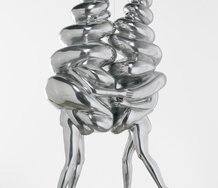
This Discussion has 0 comments.
Comment
Participate
Register to Participate.
Sign in
Sign in to an existing account.